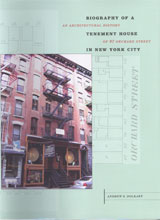Book Review
Biography of a Tenement House in New York City: An Architectural History of 97 Orchard Street
By Andrew Dolkart. Santa Fe, NM: Center for American Places, 2006; 160 pp., b&w and color illustrations; cloth $27.50.
 |
In Biography of a Tenement House, Andrew Dolkart provides an overview of the architectural and social history of 97 Orchard Street, now the Lower East Side Tenement Museum in New York City. Constructed in 1864 and re-opened as a storefront museum in 1988, the tenement interprets the legacy of immigrants who transformed the urban landscape of New York and the United States. Dolkart treats the architectural history of 97 Orchard Street as the bones for interpreting that legacy.
In the book, Dolkart takes readers on a tour of the tenement, pointing out and illustrating the building's historic wooden embellishments, wallpapers, and paint colors. He does not depend on description alone but continually returns to the topic of human interaction with the building. He comments on many of the structure's key elements and their connection with the passage of building codes and laws, safety concerns, and public sentiment. Late 19th- and early 20th-century changes to the building fabric came in response to laws intended to improve ventilation, sanitation, and the quality of life generally for tenement residents. Fire escapes and escape doors were among those features, for example, integrated into tenement buildings in response to disasters in other buildings.
The mid-19th-century tenement building boom in New York came in response to successive waves of European immigrants, many of whom settled on the Lower East Side. The ethnic mix of residents included Irish, German, and Russian immigrant families who worked as artisans, dressmakers, and even surgical instrument makers. Many people, however, viewed tenements as overcrowded and rife with public health problems.
The story of 97 Orchard Street is tied to the history of social activism in New York City. Dolkart describes the contributions of social reformers involved in the Charity Organization Society and the Tenement House Commission on tenement life, and he points out how those contributions affected the design of buildings. The city required skylights, for instance, to provide daylight and ventilation to the building interiors. The owners of 97 Orchard Street initially complied with this mandate by replacing wooden door panels with textured glass; the skylight came a few years later.
The Tenement Museum has done an extraordinary job of weaving together the architectural history of 97 Orchard Street and the stories of the people and families who lived there. For his part, Dolkart outlines the demographics of New York City's Tenth Ward to show that the tenement reflected the ethnic makeup of the neighborhood. Even though the book is primarily an architectural history, more information on the specific people and families who lived and worked at the tenement would be beneficial to illuminating the relationship between architecture and those who inhabit it.
Dolkart outlines the administrative history of the museum but only briefly describes the process of restoration and rehabilitation. No mention is made of the interesting artifacts recovered in archeological excavations conducted in the backyard. This reviewer would have liked more information on the restoration architects' and historians' use of comparable buildings in the Lower East Side for guiding the reconstruction and the selection of historic paints, wallpapers, and architectural features.
That said, Biography of a Tenement House is clearly written and easy to read. This reviewer has visited the Lower East Side Tenement Museum several times, and Dolkart covers more in a slim volume than any single guided tour can possibly cover in one hour. A great complement to a guided visit, the book answered many of this reviewer's questions about the development of 97 Orchard Street and the choices made regarding its interpretation to the public. Appropriate for both student and professional audiences, it can serve as a useful "how to" and "why we do what we do" case study for museum studies and related cultural resource management classes.
Cultural resources professionals involved in historical site interpretation will also appreciate this book. Dolkart has done a good job of demonstrating how architectural form has followed function, and vice versa. He has also done an admirable job of recounting the story of 97 Orchard Street's remarkable transformation from an old tenement into a new museum.
Teresa S. Moyer
Washington, DC
